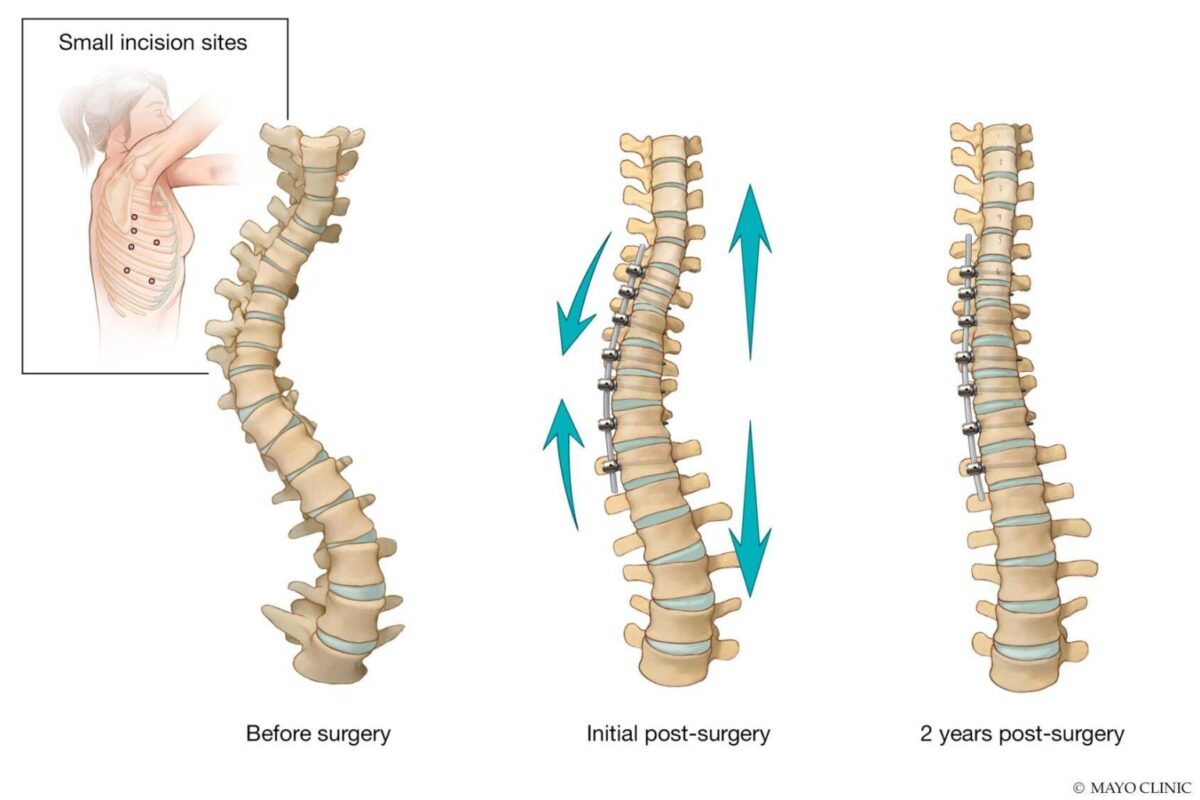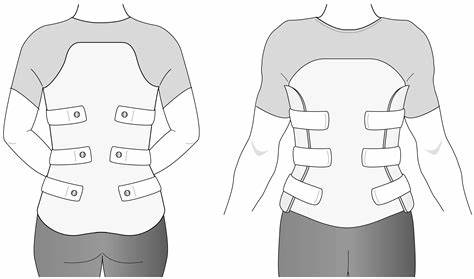Scoliosis is a medical condition characterized by an abnormal curvature of the spine. It affects people of all ages, but it is most commonly diagnosed during adolescence. The curvature can be in the shape of an “S” or a “C” and can vary in severity. This condition can have a significant impact on an individual’s functional abilities and daily life. Understanding the basics of scoliosis is crucial in order to comprehend its effects and explore potential treatment options.

Types of Scoliosis: Exploring the Different Classifications
There are several types of scoliosis, each with its own unique characteristics. The most common type is idiopathic scoliosis, which has no known cause. It typically develops during adolescence and affects girls more frequently than boys. Other types include congenital scoliosis, which is present at birth and caused by abnormal spinal development, and neuromuscular scoliosis, which is associated with conditions such as cerebral palsy or muscular dystrophy. Understanding the different classifications of scoliosis is essential for accurate diagnosis and appropriate treatment planning.

Causes and Risk Factors: Unraveling the Origins of Scoliosis
The exact cause of idiopathic scoliosis remains unknown, but researchers believe that a combination of genetic and environmental factors may contribute to its development. Some studies suggest that certain genes may predispose individuals to scoliosis, while others propose that hormonal imbalances during puberty could play a role. Additionally, certain risk factors, such as a family history of scoliosis or a history of certain medical conditions, may increase the likelihood of developing the condition. Unraveling the origins of scoliosis is crucial for early detection and intervention.
Signs and Symptoms: Recognizing the Warning Signs
Recognizing the signs and symptoms of scoliosis is essential for early detection and timely intervention. Common signs include uneven shoulders, a prominent shoulder blade, an uneven waistline, or leaning to one side. In some cases, scoliosis may cause back pain or discomfort, particularly during physical activities. It is important to note that scoliosis can vary in severity, and some individuals may not experience any symptoms at all. Regular screenings and awareness of the warning signs are crucial for early diagnosis and treatment.
Diagnosis and Screening: Identifying Scoliosis in its Early Stages
Diagnosing scoliosis typically involves a physical examination, followed by imaging tests such as X-rays or MRI scans. During the physical examination, a healthcare professional will assess the curvature of the spine, measure the degree of the curve, and evaluate any associated symptoms. Early detection is key to preventing the progression of scoliosis and minimizing its impact on functional abilities. Regular screenings, particularly during adolescence, can help identify scoliosis in its early stages and facilitate prompt intervention.
Treatment Options: Navigating the Path to Recovery
The treatment options for scoliosis depend on various factors, including the severity of the curvature, the age of the individual, and the presence of any associated symptoms. Mild cases of scoliosis may only require regular monitoring to ensure that the curvature does not worsen. However, more severe cases may necessitate intervention. Treatment options can include bracing, surgical interventions, physical therapy, and exercise. Navigating the path to recovery requires a comprehensive approach that takes into account the individual’s unique circumstances and goals.
Bracing: Understanding the Role of Orthotic Devices
Bracing is a common treatment option for scoliosis, particularly in adolescents with moderate curvature. Orthotic devices, such as braces, are designed to support the spine and prevent further progression of the curvature. Bracing is typically recommended for individuals who are still growing and have a curvature between 25 and 45 degrees. The duration of bracing can vary depending on the individual’s age and the severity of the curvature. Understanding the role of orthotic devices is crucial for individuals undergoing bracing treatment and their families.

Surgical Interventions: Exploring the Possibilities
In severe cases of scoliosis, surgical intervention may be necessary to correct the curvature and prevent further progression. The decision to undergo surgery is typically based on factors such as the degree of the curvature, the presence of associated symptoms, and the individual’s overall health. Surgical interventions for scoliosis involve straightening the spine using metal rods, screws, or hooks. While surgery can be a daunting prospect, it can also provide significant relief and improve functional abilities. Exploring the possibilities of surgical interventions is essential for individuals considering this treatment option.
Physical Therapy and Exercise: Strengthening the Spine
Physical therapy and exercise play a crucial role in managing scoliosis and improving functional abilities. A skilled physical therapist can develop a personalized exercise program that focuses on strengthening the muscles surrounding the spine, improving posture, and increasing flexibility. These exercises can help alleviate pain, improve balance, and enhance overall physical function. Regular physical therapy sessions and consistent adherence to the exercise program are essential for maximizing the benefits of this treatment approach.
Psychological Impact: Addressing the Emotional Aspects of Scoliosis
Living with scoliosis can have a significant psychological impact on individuals, particularly during adolescence when body image and self-esteem are often fragile. The visible curvature of the spine can lead to feelings of self-consciousness, social isolation, and emotional distress. It is crucial to address the emotional aspects of scoliosis and provide appropriate support and counseling to individuals and their families. Building a strong support system, connecting with others who have experienced scoliosis, and seeking professional help can all contribute to a positive psychological outlook.
Living with Scoliosis: Coping Strategies and Support Systems
Living with scoliosis requires individuals to develop coping strategies and establish support systems. Engaging in activities that promote physical and emotional well-being, such as yoga or meditation, can help manage pain and reduce stress. Building a support network of family, friends, and healthcare professionals who understand and empathize with the challenges of scoliosis is crucial. Additionally, joining support groups or online communities can provide a sense of belonging and a platform for sharing experiences and advice.
Future Research and Advancements: Promising Developments in Scoliosis Understanding
Advancements in scoliosis understanding and treatment are continuously being made through ongoing research and technological innovations. Researchers are exploring the genetic and molecular mechanisms underlying scoliosis, which may lead to targeted therapies in the future. Additionally, advancements in imaging techniques and surgical procedures are improving the accuracy and effectiveness of scoliosis treatment. Staying informed about the latest research and advancements is essential for individuals with scoliosis and their healthcare providers.
In conclusion, understanding scoliosis and its impact on functional abilities and daily life is crucial for individuals diagnosed with this condition. By exploring the basics of scoliosis, recognizing the signs and symptoms, and understanding the various treatment options available, individuals can navigate the path to recovery and improve their quality of life. Addressing the emotional aspects of scoliosis, developing coping strategies, and establishing support systems are also essential for overall well-being. With ongoing research and advancements, the future holds promising developments in scoliosis understanding and treatment.
References
- Hresko MT. “Clinical practice. Idiopathic scoliosis in adolescents.” New England Journal of Medicine. 2013;368(9):834-841. doi: 10.1056/NEJMcp1209063.
- Weinstein SL, Dolan LA, Cheng JC, Danielsson A, Morcuende JA. “Adolescent idiopathic scoliosis.” The Lancet. 2008;371(9623):1527-1537. doi: 10.1016/S0140-6736(08)60658-3.
- Negrini S, Donzelli S, Aulisa AG, et al. “2016 SOSORT guidelines: orthopaedic and rehabilitation treatment of idiopathic scoliosis during growth.” Scoliosis and Spinal Disorders. 2018;13:3. doi: 10.1186/s13013-017-0145-8.
- Di Felice F, Zaina F, Donzelli S, Negrini S. “Physical exercises as a treatment for adolescent idiopathic scoliosis: an updated systematic review.” Physiotherapy Theory and Practice. 2020;36(5):524-542. doi: 10.1080/09593985.2018.1493161.
- Danielsson AJ, Hasserius R, Ohlin A, Nachemson AL. “A prospective study of brace treatment versus observation alone in adolescent idiopathic scoliosis: a follow-up mean of 16 years after maturity.” Spine (Phila Pa 1976). 2007;32(20):2198-2207. doi: 10.1097/BRS.0b013e31814b80eb.
- Smith JS, Shaffrey CI, Berven S, et al. “Prospective multicenter assessment of perioperative and minimum 2-year postoperative complication rates associated with adult spinal deformity surgery.” Journal of Neurosurgery: Spine. 2010;13(5):584-591. doi: 10.3171/2010.5.SPINE0946.
- Stokes IA. “Analysis and simulation of progressive adolescent scoliosis by biomechanical modeling.” Spine (Phila Pa 1976). 2007;32(2):129-137. doi: 10.1097/01.brs.0000251863.94482.83.
- Aebi M. “The adult scoliosis.” European Spine Journal. 2005;14(10):925-948. doi: 10.1007/s00586-005-1053-9.
- Zheng Y, Dang Y, Yang Y, et al. “Surgical treatment of adult idiopathic scoliosis with posterior-only approach and pedicle screw instrumentation.” Journal of Spinal Disorders & Techniques. 2011;24(5):302-309. doi: 10.1097/BSD.0b013e31820159c4.
- McCarthy RE, Luhmann S, Lenke L, McCullough FL. “The management of thoracic scoliosis: anterior versus posterior surgery.” Orthopedic Clinics of North America. 1994;25(2):225-236. doi: 10.1016/S0030-5898(20)31611-3.
- Luk KD. “Scoliosis evaluation, treatment indications, and options.” Asia Pacific Spine Journal. 2016;10(3). doi: 10.1016/j.apjs.2016.06.001.
- Berdishevsky H, Lebel VA, Bettany-Saltikov J, et al. “Physiotherapy scoliosis-specific exercises—a comprehensive review of seven major schools.” Scoliosis and Spinal Disorders. 2016;11:20. doi: 10.1186/s13013-016-0076-9.
- Cheng JC, Castelein RM, Chu WC, et al. “Adolescent idiopathic scoliosis.” Nature Reviews Disease Primers. 2015;1:15030. doi: 10.1038/nrdp.2015.30.
- Reamy BV, Slakey JB. “Adolescent idiopathic scoliosis: review and current concepts.” American Family Physician. 2001;64(1):111-116. doi: 10.1007/s10437-005-0002-7.
- Bunnell WP. “The natural history of idiopathic scoliosis before skeletal maturity.” Spine (Phila Pa 1976). 1986;11(8):773-776. doi: 10.1097/00007632-198610000-00006.

